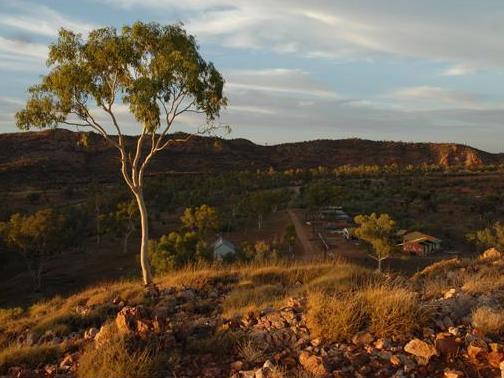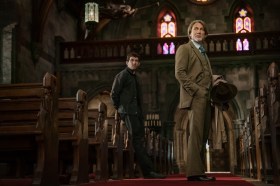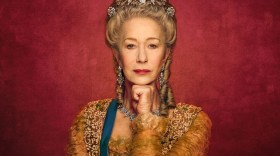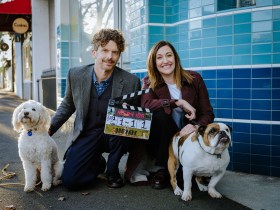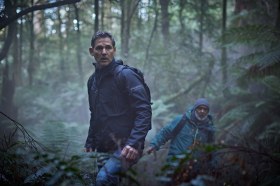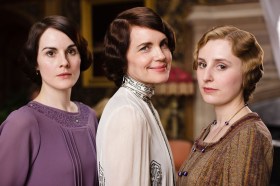Image: On the desert set of Samson & Delilah. Source: Scarlett Pictures.
There are times in my life when I have looked back on the important milestones, those moments when things started or ended, moments that didn’t seem significant at the time but with the benefit of hindsight were monumental and life-changing. I had such an experience one day back in 1989. On that day I met, in quick succession, Freda Glynn, Erica Glynn and Warwick Thornton.
I had travelled to Alice Springs to teach sound recording to the current intake of trainees at the CAAMA (Central Australian Aboriginal Media Association) television unit. I went with John Whitteron and Tony Stephens, who were there to teach cinematography and editing, respectively.
On our first teaching day, John, Tony and I drove to CAAMA and met up with Freda Glynn, who was to be our boss for the time we were there. CAAMA Radio had been an exciting and successful venture for about a decade by that time, and Imparja TV had recently been launched in Alice Springs, with a big shiny new building. CAAMA was the brainchild of Freda Glynn, Phillip Batty and John Macumba, but Freda ran it. Freda spoke quietly but she was clearly the one in charge. Freda inducted us and conducted a tour of the CAAMA building. We were to be based in the shed-like CAAMA TV soundstage.
While we were having our tour a film crew returned to CAAMA in a 4WD Toyota and started to unpack their gear. A young woman holding a clipboard came over to Freda and started talking to her. I thought she was very beautiful and so cool! I’m sure I remember her wearing a black leather jacket but now, as I think back, it would seem an impractical wardrobe choice for a filmmaker out on a shoot in Central Australia.
Freda introduced her to us as Erica, her daughter, a trainee in an earlier intake she was now working for CAAMA as a producer. Erica was polite but basically took no interest in us. Warwick told me years later that, at the time, she was making a documentary about the artist Emily Kngwarreye, long before she became world famous. From that point on, although I saw her at a distance (did I mention how cool she was?), our paths at CAAMA hardly crossed.
Finally, on that day, we were to meet the current crop of trainees we would be teaching. That is when I met Warwick Thornton. I remember being introduced to the group and being struck by how shy they all seemed. The trainees I remember the clearest were Warwick (who I knew was Freda’s son), Jason (whose surname is lost to me in the mists of time but who I think was from Tasmania), and Rachel Perkins (who I vaguely knew because she went to school with my younger brother in Canberra).
It became pretty clear early on that the trainees were only interested in learning about the camera, although some were interested in editing. None of them were very interested in sound recording. And it became clear that access to the cameras was down to whoever got in first. My memory tells me that this was usually Warwick and Jason, and they didn’t do any sound recording.
The equipment we had to work with was basic. At the time they were shooting on U-matic portapaks, which consisted of a 3/4-inch video recorder carried over the shoulder with a video camera connected to it. Sound was recorded on a Nagra reel-to-reel recorder (weighing 10 kgs!), which sent sound through a cable connecting it, like an umbilical cord, to the U-matic recorder.
I decided that Rachel was an obvious future sound recordist, and I remember spending more time teaching her sound than any of the others, diligently tutoring her in the craft of boom swinging and the dark art of microphone placement. She was very polite about it. Retrospectively, I think I might be responsible for her subsequent career choice and success as a producer and director!
One day, John Whitteron took a group of trainees out of town to shoot the sunrise. When they returned we gathered to watch what they had filmed. I remember being struck by how beautiful Warwick had made the sunrise look on 3/4-inch video and I remember there was much praise for his work. He was a tall, skinny, shy and slightly awkward kid at the time, but on that day he was the hero. I don’t want to romanticise the occasion too much but when I heard years later that he was doing cinematography at the AFTRS (Australian Film, Television and Radio School) I was not at all surprised.
The other highlight of that trip was discovering the amazing music that was being recorded by Indigenous artists at CAAMA radio. They were on sale as cassettes in the CAAMA shop. I loved bands like the Wedgetail Eagle Band, Areyonga Desert Tigers and Ilkari Maru, and bought as many cassettes as possible. I had no idea that many years later I would rediscover them all over again while working with Warwick on the sound for his films Green Bush and Samson & Delilah.
Erica told me that Freda auditioned for the lead role in Charles Chauvel’s Jedda (the part went to Rosalie Kunoth-Monks). This intrigued me because not long after I had been at CAAMA I was the sound recordist on Tracey Moffat’s Night Cries: A Rural Tragedy, an imagined sequel to Jedda. Professor Marcia Langton played the role of an older, grown- up Jedda.
Beck Cole once said that seeing Night Cries was what made her pursue a career as a film director. She went on to collaborate with Warwick on many projects, later casting Professor Langton in her feature film Here I Am, on which Warwick was the director of photography and I was the sound designer. The producer of Night Cries was Penny McDonald, who later became Warwick’s partner. They had two children together, Rona and Dylan. I remember seeing Penny when she was pregnant with Dylan but it never crossed my mind that 20 years later I would be working as the sound designer, with Dylan as my director and Penny as producer on the amazing documentary Buckskin.
Warwick and I were brought back together in the early 2000s when producer Kath Shelper asked me to be the sound designer on Warwick’s short film Green Bush, and Beck Cole’s film Plains Empty. Both films had been invited to the Sundance Film Festival and they needed to be finished on a tight schedule that went over Christmas and New Year. Beck and Warwick brought their daughter Luka May, who was only a baby, to the sound studio for the duration and I remember it as an intense, creative happy experience full of summer sun. I continued to work with Warwick as his sound designer during a period of success for him, with Green Bush, Nana, and Samson & Delilah all winning awards around the world.
Samson & Delilah is almost ten years old now but it still resonates with people. It got under the skin of the national psyche. It affected people in ways that they never expected. It changed the way people think. As a film, it is greater than the sum of its parts. I have sound designer credits on 40 feature films and have been the sound designer on 16 feature films since Samson & Delilah, but it is still the one people want to talk with me about the most!
I am sure there are many who have worked with Warwick, who would agree that the highest compliment he gives is ‘That’s gorgeous!’. When he says that to me I know my work has touched him.
There are lots of stories I can tell about Samson & Delilah but one comes to mind now because it also involves Erica. She would know that I couldn’t possibly write this piece without recounting it!
We were having a screening to investors etc. on the final day of our final sound mix. In attendance were producer John Maynard and funding body representatives including Miranda Dear, Sally Riley and Erica Glynn (who was, at the time, head of the Indigenous unit at Screen Australia, I think). Warwick addressed the gathering, saying he was very proud of the film and didn’t want to change a thing. This is a speech I’ve heard him make many times. I think one of Warwick’s strengths is he knows instinctively when something is right. He just knows when the story has been told, through picture or sound, and when to embellish, or not to embellish, further. He trusts his creative collaborators but when he is happy with the result he knows when to stop.
After the screening, when the lights came on, Erica looked around the room and demanded to know why the soundtrack was filled with ‘all those bloody New South Wales birds!’.
Warwick and I had carefully considered the birds heard in the film. We had developed a totemic motif with Australian ravens and sulphur-crested cockatoos for the characters of Samson & Delilah. We had also used the sounds of topknot pigeons because Warwick loved the distinctive cooing sound they made. Erica was right though; many were from New South Wales, although they did cross the border into Central Australia. I stayed fairly quiet but it was great to see Warwick mount a defence as the two siblings ‘debated’ the provenance of the wildlife in the film!
I am now always rigorous about only using bird calls that would be heard in the locations depicted in the films I work on, and I research it carefully. Thank you, Erica!
It’s comforting for me to know that once Warwick has decided something in the soundtrack works, he will defend it vigorously. Following his ‘I’m very proud of this film and I don’t want to change a thing’ speech he has subsequently defended decisions we made with the sound for True Gods and Big World (his contributions to the film anthologies Words With Gods and The Turning, respectively).
Both Warwick and Erica have opened my ears to new sounds that I didn’t even realise existed. They have both asked me, at different times, on different films they have directed, and without reference to each other, to put in the sound of a plane passing 35,000 feet (approximately 10 kilometres) overhead. Living and working in Alice Springs, this is a sound they are familiar with, but I have never lived in a place where this sort of sound is heard and would never think to put it into a film. It’s a sound that is only heard in extremely quiet places under a flight path (like Alice Springs), where the ambient noise level all around is so low that you can actually hear something 10 kilometres away. Warwick described it to me, and we put it in Samson & Delilah, heightening the scenes it is used in by adding it as an emotional texture at strategic points in the film.
Erica also asked me to put this sound in her beautiful, sad, inspiring film Truth Be Told, about the Indigenous soldiers who fought in the battle of Beersheba in World War I. In this context the sound of the distant plane passing was used as a metaphor physically linking Australia and Israel, but also connecting the past to the present through distant memories.
Luckily the Glynn family likes cats because I have four of them (and up to seven at one point)! At various times Erica, Tanith, Dylan and Warwick have shared space with them while working with me at home. Harlequin went missing during the sound edit for Samson & Delilah and I don’t think Warwick even thought twice about letting me take off a week to find him. Harlequin is now safely back home and I remember Dylan was keen to meet him the first time he came to my house, such was the build-up he was given by Warwick! Warwick still asks about Harlequin and likes to tell stories about The Darkness, his deaf white cat back in Alice Springs. He was insistent that the soundtrack of Samson & Delilah contained some sounds made by Milky, his Chihuahua, and if you listen carefully Milky can be heard barking in the background with the other community dogs in the first half of the film!
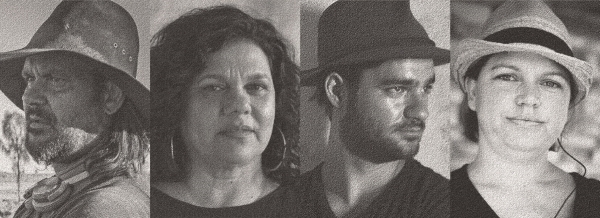
Image: L-R: Warwick Thornton, Erica Glynn, Dylan River and Tanith Glynn-Maloney. Source: Wakefield Press.
There are times when I’m working with Dylan, and he’s sitting behind me, I can swear that the voice I’m hearing is Warwick’s. Not so much the words he speaks but the sound of his voice, the timbre and the pitch. It’s uncanny! But Dylan has his own voice and his own stories to tell.
From biographical films like Buckskin, which tells the story of Jack Buckskin, who is trying to revive the Aboriginal language of his ancestors in South Australia, or Finding Maawirrangga, about the redemption of the late Tom E. Lewis, to the humorous but achingly tragic Nulla Nulla, or his ‘modern dreamtime’ interpretation of the story of the emu and the kangaroo in Coat of Arms, Dylan is trying to tell important stories while always keeping his audience entertained.
Dylan is an impressive musician and composes the music for most of his films himself. This allows my collaborations with him to grow organically as we work together to create a soundtrack where music and sound design merge to convey pure emotion at times.
I should mention at this point that he and his sister Rona performed the music for what I think is the greatest music cue ever composed for an Australian film. I’m referring to the cue S4D Sad Song, from Samson & Delilah, when Samson is banished from his community. Dylan’s sparse electric guitar and Rona’s delicate and brittle violin combine to make the hairs stand up on the back of my neck. Every time!
I’m so excited to see what Dylan does in the future. Having worked with him on four short films and two documentaries, I can say with certainty that he will be an important contributor to the Australian cultural conversation in coming years.
The first words I ever heard Tanith Glynn-Maloney speak were, ‘What the fuck are you looking at!’ Sadly for my story, these were not the words of Tanith but, rather, Jody, the character she played in Beck Cole’s beautiful, way-before-its-time feature film, Here I Am, about an Indigenous women’s halfway houseI’. There’s definitely a hint of Jody in Tanith but without the world-weariness – and with a much better sense of humour!
I’ve worked with Tanith as producer on numerous films directed by Dylan. It’s exciting to watch a new generation of the Glynn family, who weren’t even born when I met Freda, Warwick and Erica, tell their stories with a fresh original voice. This includes Warwick and Beck’s now almost grown-up daughter, Luka May Glynn-Cole, who is starting to make her mark as an actor.
In recent years it has been so good to see Freda as the mother and nana, at screenings or after parties for films made by her children or grandchildren, a proud matriarch enjoying their success!
As a sound guy, I spend a lot of time with clients behind me while I work on the sound. The nature of my job means a lot of time is spent listening to sounds, and while they are playing there is no room for talking. I realise that I have spent literally hundreds, perhaps thousands, of hours with Warwick, Erica, Dylan and Tanith sitting behind me, none of us speaking, just absorbed by sound and image. I can honestly say that at these times I’ve often felt my most creative and most content.
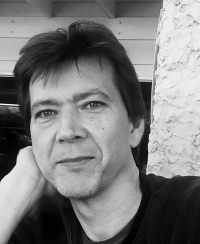
Image: Liam Egan. Source: Wakefield Press.
